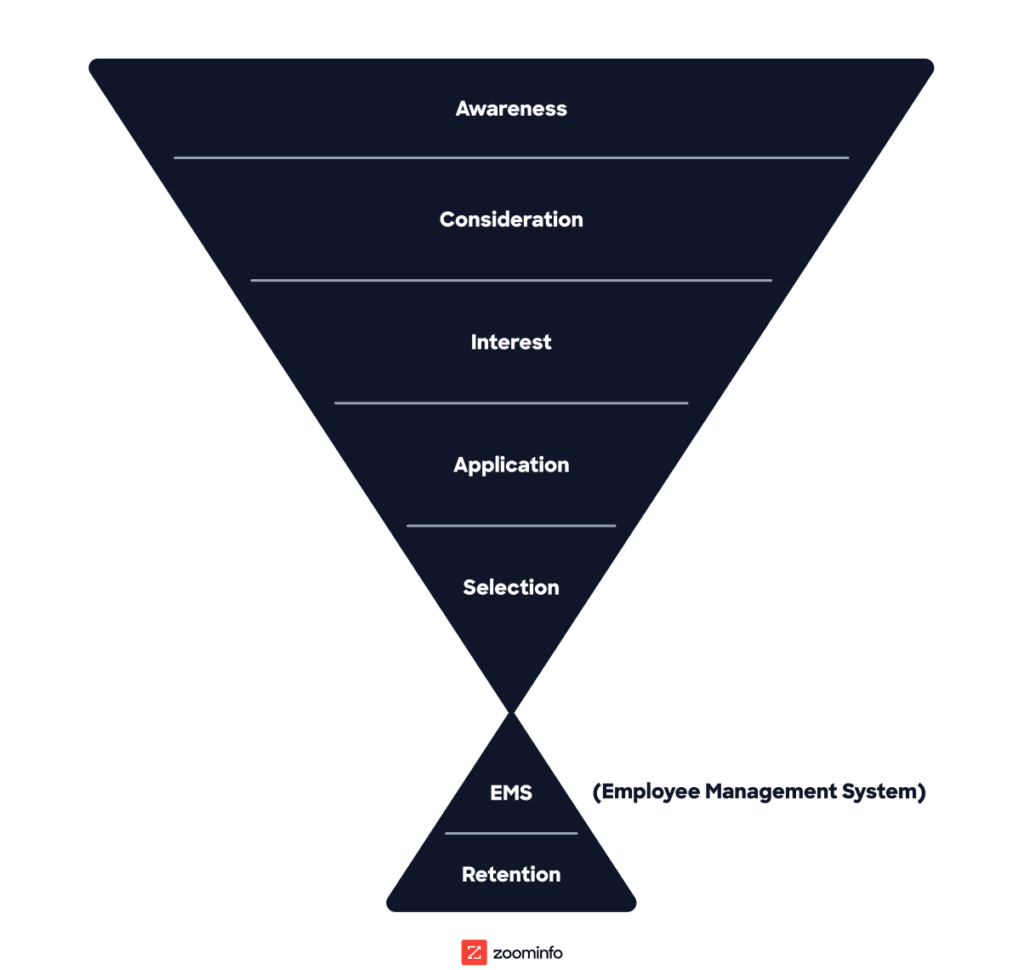The COVID-19 pandemic hit recruitment and hiring professionals with a massive one-two punch of disruption. Even before the pandemic, a far more fluid, labor-driven hiring market meant the time-tested methods for interviewing and hiring candidates were becoming outdated.
Here, we examine the digital recruiting funnel and identify tech strategies that recruiters can adopt to drive better outcomes for their business.
The similarities between sales, marketing, and recruiting
While each department has separate business functions, salespeople, marketers, and recruiters perform many of the same activities. That’s because each process has a digital funnel at its core:
What is the recruitment funnel?
The recruitment funnel is a set of consecutive processes that enable talent acquisition teams to build a large pool of viable candidates, and then narrow that list down to the most desirable candidates from which to select and hire.
Figure: A Visual Depiction of The Digital Recruitment Funnel

Much like marketers promoting products to targeted audiences, in order to run this recruitment funnel efficiently, recruiters must develop their employer brand, create a great candidate experience, and offer job opportunities with attractive compensation and rewards to convert them into employees.
Much like marketers who promote products to customers, recruiters promote their company as an employer to potential candidates. Technology can go a long way in optimizing the recruitment funnel, especially when it comes to identifying, reaching, and communicating with talent.
In addition to targeting the right talent, it’s also important for companies to develop their employer brand, create a great candidate experience, and offer job opportunities with attractive compensation and rewards to convert them into employees.
Building a stronger recruitment process with tech strategies
In today’s candidate-driven talent market, timing is everything. To drive better results in their hiring process, recruiters are employing proven strategies from marketing and sales in order to start engaging people sooner and with more context.
Here are some of the most effective tech-savvy practices to adapt to your recruitment funnel:
1. Rely on better data
“Our customers—recruiters and talent acquisition professionals—have found real success using data and proactive outreach methods on LinkedIn,” says Henry Schuck, CEO at ZoomInfo. “They are now realizing that leveraging data on professionals, and marrying it with technology that automates outreach and engagement at scale, can meaningfully drive down cost and time per hire.”
2. Act based on real-time information
With Scoops, recruiters can create a search for the ideal candidate profile based on job title, industry, experience, and other criteria, then filter for things like layoffs, management moves, and other organizational activities to help identify candidates within companies that might be affected.
3. Invest in a recruiting tech stack
With an influx of hiring activity, recruiters are taking special care around managing the candidate experience. Digitization and improved technology solutions formerly reserved for sales and marketing functions are now emerging as viable recruitment tools as well.
A high-quality recruitment management platform can increase the speed and efficiency of sourcing candidates and overall better align your entire recruitment funnel. It allows you to easily filter candidates based on location, industry, skills, and other criteria.
4. Personalize candidate outreach
Using personalization in the recruitment funnel is just as effective as it is for sales and marketing. Nick Geifman, a senior talent acquisition manager at ZoomInfo, says he’s found a lot of success by making his outreach about the candidate, rather than the employer.
“Blasting out the same message to a variety of candidates and hoping for someone to bite is not the most strategic way of recruiting,” Geifman says. “It’s all about slowing it down and figuring out where there is a potential connection with the candidate. Whether it’s a school, or a skill set, or anyone we have in common — whatever it is, I try to make it a little bit more personal.”
5. Automation FTW
For example, applicant tracking systems (ATS) can go further to automate candidate matching, make it easier to iterate messaging, and enable the team to measure performance around recruiting KPIs. The predictive analytics that emerges from your centralized database can also help businesses plan recruitment efforts, make better hiring decisions, and help with workforce planning.
6. Leverage AI
Artificial intelligence is the future of recruiting. According to Ideal, a recruitment technology firm, companies that are early adopters of AI-powered recruiting have seen:
Cost per screened candidate reduced by 75%
4% increase in their revenue per employee
35% decrease in turnover
The key function of AI and natural language processing (NLP) in the recruitment process is to reduce the number of repetitive tasks recruiters must do. Implementing AI in the recruitment process has the potential to change everything from the screening process to the outreach process and can even go a step further to help with eliminating biases within set processes.
Embrace technology strategies throughout your recruitment process
Implementing sales and marketing technology strategies in your organization’s recruitment process can have a huge impact on how you attract and engage candidates. It can help to improve everything from who you target, how you reach them, the messages you use to capture interest, and even the time it takes to hire them.


